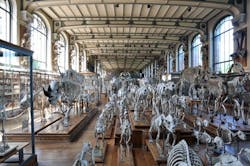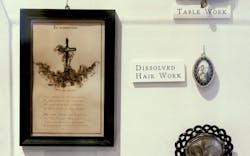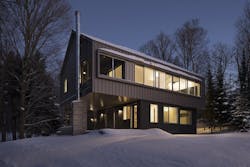Architects and Traveling
Architects like to travel, at least that’s what all my friends who are architects would like you to believe. While I will agree that this is a true statement, I think it’s a fairly generic statement because don’t all people like to travel?
In this fourth episode of the Life of an Architect podcast, Landon and I take on the topic of traveling – or at least we start a conversation about traveling. When we sat down to prepare our show notes, it quickly became apparent that this was a topic worthy of several episodes. So to that end, we start with some of the up-front bits of traveling – traveling as a young person compared to a more “mature” person, traveling with children, packing, architectural bucket lists, and traveling for work. So much good stuff – so check out the podcast and be sure to stick around to the very end … the last two minutes are quite memorable.
Hard to believe that this is what I used to look like … young.
Traveling in Europe as a Student (6:10 mark)
27 years ago, as a fourth-year architecture student, I spent the Fall semester traveling around Western Europe soaking in all the architectural wonders I could find. I was 22 years old and had done very little traveling of any kind … through the good graces of my parents, The University of Texas School of Architecture, and Virginia Tech, I was able to travel extensively at an age when I was barely prepared to do much of anything in the real world. Most of what I learned from that time didn’t have as much to do with architecture as I anticipated … I grew up.
Since my college trip to Europe predates the widespread use of the internet, the only way to really communicate with people back home was through letters and postcards. I will admit that my parents kept every postcard and letter I sent home and gave them to me once I got back … and I have kept all of them to this day.
Traveling with Children (8:20 mark)
During a trip to the Museé d’Orsay, I was reminded of how to look at something by my 5-year-old daughter. Sometimes you have to slow down in order to see what you are looking at – a lesson that I didn’t learn until I was forced to learn it when my wife and I took our daughter to Paris. Little kids are great at doing lots of things but walking around fancy museums for hours on end is not one of them. As expected, after about 30 minutes my daughter said she was bored and I wasn’t ready to leave. In an effort to extend our stay, I picked her up and started carrying her around with me as we looked at the paintings.
Distraction tactics commenced.
Au Café dit L’Absinthe by Degas, Museé d’Orsay, Paris, FranceSad Woman in a Bar (10:30 mark)
This painting in particular, by Edgar Degas, captured the imagination of my daughter and she spent the better part of 15 minutes coming up with a narrative on why this woman looked so sad. Kids are funny that way, their impatience or intolerance with a thing typically comes from not understanding it or from being disinterested in the current activity. The slightest of changes will impact the way they see something, and as a result, their behavior will change your behavior.
Bring your kids to museums.
Packing (24:40 mark)
I am a packing master – and this is the weekend bag that I use as often as I can. I will readily acknowledge that roller-bags are easier to move around but the old-school version of me thinks this is more manly. I have already taken about a dozen trips through the first seven months of the year, and have another Five taking place within the next two months – somewhere in the neighborhood of 40,000 miles – and my average trip lasts no more than 3 days. Unless I am packing 3″ D-ring binders and stone samples, I prefer to carry a bag with some style.
Favorite Building in Paris and “The Herd” (21:14 mark)
The Galeries de Paléontologie et d’Anatomie Comparée (Gallery of Paleontology and Comparative Anatomy) is a jewel. Part of the French Muséum national d’histoire naturelle (Natural Museum of Natural History), it is located within the Jardin des Plantes in Paris near the metro stop for Gare d’Austerlitz, and it is full of amazing treasures.
This building and the exhibits within should be on every single person’s “to-do” list if they are going to Paris … especially if you have children.
Human Hair Exhibit (23:32 mark)
All I can say is gross … like, really, really gross. There is even a section titled “Wet Specimens”
[Shudder]
Rather than subject you to things that I’d just as soon not look at, I am going to give you a choice that I didn’t have. If you want to hands with gout (part of the wet specimens collections) – click here. Maybe a dermoid cyst of the ovary is more your speed? You’ll want to click here. Will I secretly be judging you for clicking on those links … absolutely. Let me just tell you that I would rather eat pickled pig skin than walk through an exhibit full of these appetite-restricting jars of horror.
Maybe human hair art is more to your liking … like it apparently is for Landon.
“I have always been looking for domes with hair work in them. ..” said John Whitenight, one of the contributors to the special exhibition Woven Strands: The Art of Human Hair Work at the Mutter Museum of the College of Physicians of Philadelphia until September 16, 2018.
Traveling for Work (31:13 mark)
We had a wonderful project wrap up last year – the BSB Cabin – and I have covered it fairly extensively here on the site … but I’ve never shared the story of when Landon and I took a trip up together to work on the final closeout of this project. Landon and I had a lot of work going on in the office and while the idea of spending 1 or 2 weeks up North sounded great, it was going to cause some workflow problems. As a result, this was a working trip for us both … and Landon had to bring his desktop computer, monitor – the whole thing – with him on this trip. Treating it as carry-on luggage and getting it through security was an adventure.
In My Spare Time (41:50 mark)
What do architects do in their spare time? I have been asking this question for years without ever having received a response that genuinely felt like a legitimate answer. It would appear that like me and this website (and now the podcast) that a lot of architects simply do more architecture once they leave the office. Since I don’t want that to be true, I am going to try and do something about it and I am going to talk about things that interest me that are outside the sphere of architecture. Landon and I decided to introduce this segment in this week’s podcast and we started off by asking Landon what he’s been doing in his spare time.
Apparently, the answer was “Build a computer.”
I found this to be particularly interesting because I receive emails all the time from young students asking me what sort of computer they should buy – and after listening to Landon, this computer he built (for just under $1,600) is a powerhouse of a system. It took him some research time to learn what all the parts were, what role they played, and then how best to strike a balance between performance and cost. Here is the system he put together …
1. CASE – $125 – Corsair Vengeance Series Military Green C70 Mid Tower Computer Case
2. and 3. CPU + MOTHER BOARD – $300 AMD Ryzen 5 1600X Processor (YD160XBCAEWOF) and MSI Gaming AMD Ryzen B350 DDR4 VR Ready HDMI USB 3 ATX Motherboard (B350 GAMING PLUS)
4. CPU HEATSINK – (1) $30 – Cooler Master Hyper RR-212E-20PK-R2 LED CPU Cooler with PWM Fan, Four Direct Contact Heat Pipes
5. GPU – $600 ASUS GeForce GTX 1070 8GB ROG STRIX OC Edition Graphic Card STRIX-GTX1070-O8G-GAMING
6. FANS – (3) $20 – Noctua NF-F12 PWM Cooling Fan
7. RAM – $169 (2) 8 GB CORSAIR Vengeance LPX 16GB (2 x 8GB) 288-Pin DDR4 SDRAM DDR4 3000 (PC4 24000) Desktop Memory Model CMK16GX4M2B3000C15R
8. SSD – $160 Samsung 850 EVO 500GB 2.5-Inch SATA III Internal SSD (MZ-75E500B/AM)
9. POWER SUPPLY – $90 Seasonic FOCUS Plus Series SSR-650FX 650W 80+ Gold ATX12V & EPS12V Full Modular 120mm FDB Fan Compact 140mm Size Power Supply
Bonus: HARD DRIVE (Optional additional storage): WD Blue 1TB SATA 6 Gb/s 7200 RPM 64MB Cache 3.5 Inch Desktop Hard Drive (WD10EZEX)
I asked Landon now that he has had the system for a few weeks, how is it working?
“Gloriously.”
I decided to go in a direction far less technical. Most of my spare time is spent on this blog and the new podcast – but I still gotta eat, right?
I really enjoy cooking – a lot. It is something that I could see myself doing in a full-time capacity (assuming that I could skip the “cleaning up the dishes” part). The way this urge to cook manifests itself is through smoking barbeque – something that I have been actively doing for almost 15 years.
I haven’t gone crazy with the gear – something that is really easy to do – but I do have a nice set-up and it allows me to work on my craft. I have included below everything someone would need (other than wood and meat) to get started should they want to give smoking bbq a go.
Old Country BBQ Pits Pecos Smoker ($400 ±)
My smoker came from Academy Sports and it has proven to be worth the $400 I spent on it. All the things that would make it better (thicker steel, bigger firebox, larger cooking area) would drive up the cost beyond my current comfort level. Any bigger and I think I would feel compelled to make this a side hustle rather than a hobby.
Franklin Barbeque: A Meat-Smoking Manifesto ($12)
Texas has a lot of really great bbq joints – but few would disagree that Aaron Franklin is the current King of the Mountain. I picked up this book and it is full of what you need to know to smoke barbeque … including how to build your own smoker (something that I would love to try … one day).
ThermoPro TP20 Wireless Digital Thermometer ($60)
I literally have about a dozen digital thermometers and I am constantly trying to find one that suits my needs. This TermoPro thermometer is the latest one I’ve picked up and so far, after 3 cooks, it is still doing a great job. It is important to keep an eye on the temperature of your meat and if I was a lot better, I probably would be able to know where things are at just by feel … but I just don’t smoke often enough to add that skill set to my bag of tricks.
Dozyant 3 1/8″ Large 550° Temp Gauge Grill Thermometer – 3″ Stem Stainless Steel RWB ($12)
A pretty boring piece of equipment, but other than the smoker itself, this is probably the most important piece of equipment you will buy. Never trust the thermometer that comes with your grill, they never seem to be very accurate. I’ve done a lot of heat tests on my smoker and can confirm that this $12 thermometer (which attaches to your grill to measure the air temp, not plunged inside your meat) is spot on for me.
Traveling was a great topic for our fourth episode and I know that this is a subject matter that we will come back to on several occasions. It would have been incredibly simple to record a 3-hour episode but this is definitely a topic that will require considerable oversight … and more field research!
Cheers,












